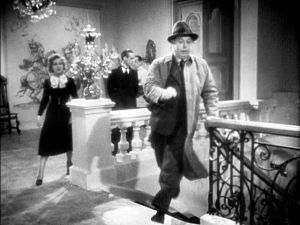Difference between pages "Beyond and Beside Narrative (Discussion)" and "Concept of Authorship (Discussion)"
From Screenpedia
(Difference between pages)
Jump to navigationJump to search (removed 2009 comments) |
|||
| Line 1: | Line 1: | ||
| − | == | + | ==Readings== |
| − | + | ===Introduction, by John Caughie=== | |
| − | + | '''Group 2''' | |
| − | + | #What are the basic assumptions of auteurist critics? | |
| − | + | #How did auteurism differ from previous film criticism? | |
| − | |||
| − | == | + | === Edward Buscombe === |
| − | + | '''Group 3''' | |
| + | #What elements of romanticism underpin auteurism? | ||
| + | #What is the difference between Hawks and "Hawks"? | ||
| − | + | === ''Cahiers du Cinéma'' === | |
| + | '''All Groups''' | ||
| + | #What is "formalism" and how did it relate to ''Cahiers''-style auteurism? | ||
| + | #What is "personalism"? | ||
| − | + | === ''Movie'' === | |
| − | + | '''Group 4''' | |
| − | #''' | + | #What was ''Movie''? |
| − | + | #How did ''Movie'''s approach to auteurism differ from that of ''Cahiers du Cinéma''? | |
| − | =='' | + | === Andrew Sarris === |
| − | * | + | '''Group 1''' |
| − | * | + | #What, according to Sarris, are the three premises of the auteur theory? |
| − | + | #*Explain, if you can, what Sarris means by "élan of the soul". | |
| − | + | ||
| − | + | '''All Groups''' | |
| − | + | #What does Sarris mean when he uses the term "mise-en-scene"? ('''Hint''': it's ''not'' how Bordwell and Thompson use it in ''Film Art''.) | |
| + | #*And how does this image (below) illustrate it? | ||
| + | [[Image:Rules Moment07.jpg|thumb|left|Jean Renoir in ''Rules of the Game'' (French title: ''La Règle du jeu'').]] | ||
| + | <br style="clear: both;"> | ||
| + | |||
| + | Pauline Kael, "Circles and Squares," ''Film Quarterly'' (reprinted in ''I Lost It at the Movies''), response to Sarris: | ||
== Bibliography == | == Bibliography == | ||
| − | + | All from ''Theories of Authorship'', John Caughie, ed. (Boston: Routledge & Kegan Paul, 1981): | |
| − | + | #Introduction, John Caughie, 9-16. | |
| − | + | #Edward Buscombe, "Ideas of Authorship," 22-34. | |
| + | #''Cahiers du Cinéma'', 35-47. | ||
| + | #''Movie'', 48-60. | ||
| + | #Andrew Sarris, 61-67. | ||
==External links== | ==External links== | ||
| + | #[http://www.tcf.ua.edu/Classes/Jbutler/T440/AuteurTheory.htm Auteur Theory Illustrations] | ||
| + | #[http://www.tcf.ua.edu/Classes/Jbutler/T340/Bazin03.htm Auteurism's defining moment], according to Sarris. | ||
| − | [[Category: | + | [[Category:TCF440/540 Discussion]] |
| − | |||
Revision as of 03:53, 22 February 2010
Readings
Introduction, by John Caughie
Group 2
- What are the basic assumptions of auteurist critics?
- How did auteurism differ from previous film criticism?
Edward Buscombe
Group 3
- What elements of romanticism underpin auteurism?
- What is the difference between Hawks and "Hawks"?
Cahiers du Cinéma
All Groups
- What is "formalism" and how did it relate to Cahiers-style auteurism?
- What is "personalism"?
Movie
Group 4
- What was Movie?
- How did Movie's approach to auteurism differ from that of Cahiers du Cinéma?
Andrew Sarris
Group 1
- What, according to Sarris, are the three premises of the auteur theory?
- Explain, if you can, what Sarris means by "élan of the soul".
All Groups
- What does Sarris mean when he uses the term "mise-en-scene"? (Hint: it's not how Bordwell and Thompson use it in Film Art.)
- And how does this image (below) illustrate it?
Pauline Kael, "Circles and Squares," Film Quarterly (reprinted in I Lost It at the Movies), response to Sarris:
Bibliography
All from Theories of Authorship, John Caughie, ed. (Boston: Routledge & Kegan Paul, 1981):
- Introduction, John Caughie, 9-16.
- Edward Buscombe, "Ideas of Authorship," 22-34.
- Cahiers du Cinéma, 35-47.
- Movie, 48-60.
- Andrew Sarris, 61-67.
External links
- Auteur Theory Illustrations
- Auteurism's defining moment, according to Sarris.
